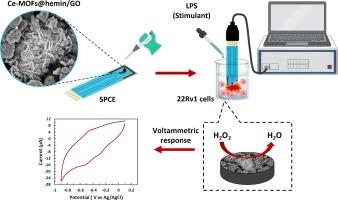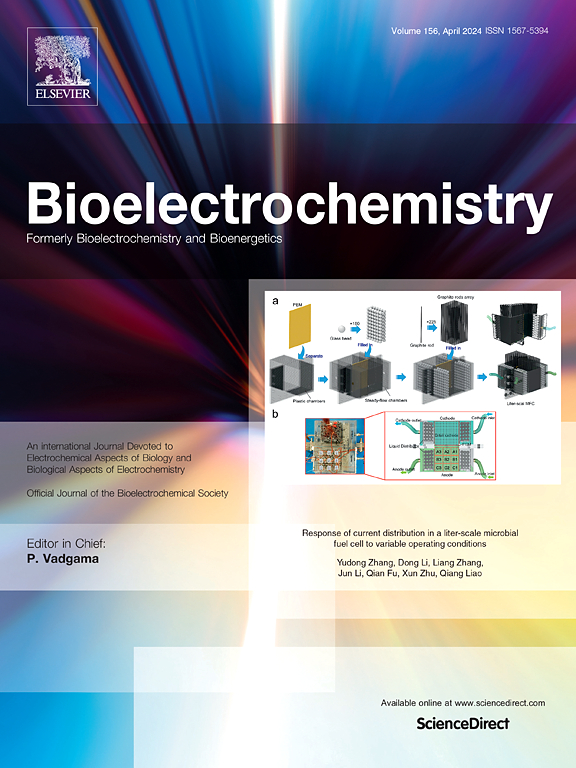A non-enzymatic hydrogen peroxide biosensor based on cerium metal-organic frameworks, hemin, and graphene oxide composite
IF 4.8
2区 化学
Q1 BIOCHEMISTRY & MOLECULAR BIOLOGY
引用次数: 0
Abstract
This study presents the development of a novel non-enzymatic electrochemical biosensor for the real-time detection of hydrogen peroxide (H2O2) based on a composite of cerium metal–organic frameworks (Ce-MOFs), hemin, and graphene oxide (GO). The Ce-MOFs served as an efficient matrix for hemin encapsulation, while GO enhanced the conductivity of the composite. Characterization techniques including scanning electron microscopy (SEM), X-ray diffraction (XRD), Fourier-transform infrared (FTIR) spectroscopy, UV–vis spectroscopy, and thermogravimetric analysis (TGA) confirmed the successful integration of hemin into the Ce-MOFs. The Ce-MOFs@hemin/GO-modified sensor demonstrated sensitive H2O2 detection due to the exceptional electrocatalytic activity of Ce-MOFs@hemin and the high conductivity of GO. This biosensor exhibited a linear response to H2O2 concentrations from 0.05 to 10 mM with a limit of detection (LOD) of 9.3 μM. The capability of the biosensor to detect H2O2 released from human prostate carcinoma cells was demonstrated, highlighting its potential for real-time monitoring of cellular oxidative stress in complex biological environments. To further assess its practical applicability, the sensor was tested in human serum samples, yielding promising results with recovery values ranging from 94.50 % to 103.29 %. In addition, the sensor showed excellent selectivity against common interfering compounds due to the outstanding peroxidase-like activity of the composite.

基于铈金属有机框架、hemin 和氧化石墨烯复合材料的非酶过氧化氢生物传感器
本研究以金属有机铈框架(Ce-MOFs)、hemin 和氧化石墨烯(GO)的复合材料为基础,开发了一种用于实时检测过氧化氢(H2O2)的新型非酶电化学生物传感器。Ce-MOFs 是封装 hemin 的有效基质,而 GO 则增强了复合材料的导电性。扫描电子显微镜 (SEM)、X 射线衍射 (XRD)、傅立叶变换红外光谱 (FTIR)、紫外可见光谱和热重分析 (TGA) 等表征技术证实了 Hemin 与 Ce-MOFs 的成功结合。由于 Ce-MOFs@hemin 的电催化活性和 GO 的高导电性,Ce-MOFs@hemin/GO 改性传感器表现出灵敏的 H2O2 检测性能。这种生物传感器对 0.05 至 10 mM 浓度的 H2O2 具有线性响应,检测限(LOD)为 9.3 μM。该生物传感器检测人类前列腺癌细胞释放的 H2O2 的能力得到了证实,突显了其在复杂生物环境中实时监测细胞氧化应激的潜力。为了进一步评估其实际应用性,该传感器在人体血清样本中进行了测试,结果令人满意,回收率在 94.50 % 到 103.29 % 之间。此外,由于复合材料具有出色的过氧化物酶样活性,该传感器对常见干扰化合物具有极佳的选择性。
本文章由计算机程序翻译,如有差异,请以英文原文为准。
求助全文
约1分钟内获得全文
求助全文
来源期刊

Bioelectrochemistry
生物-电化学
CiteScore
9.10
自引率
6.00%
发文量
238
审稿时长
38 days
期刊介绍:
An International Journal Devoted to Electrochemical Aspects of Biology and Biological Aspects of Electrochemistry
Bioelectrochemistry is an international journal devoted to electrochemical principles in biology and biological aspects of electrochemistry. It publishes experimental and theoretical papers dealing with the electrochemical aspects of:
• Electrified interfaces (electric double layers, adsorption, electron transfer, protein electrochemistry, basic principles of biosensors, biosensor interfaces and bio-nanosensor design and construction.
• Electric and magnetic field effects (field-dependent processes, field interactions with molecules, intramolecular field effects, sensory systems for electric and magnetic fields, molecular and cellular mechanisms)
• Bioenergetics and signal transduction (energy conversion, photosynthetic and visual membranes)
• Biomembranes and model membranes (thermodynamics and mechanics, membrane transport, electroporation, fusion and insertion)
• Electrochemical applications in medicine and biotechnology (drug delivery and gene transfer to cells and tissues, iontophoresis, skin electroporation, injury and repair).
• Organization and use of arrays in-vitro and in-vivo, including as part of feedback control.
• Electrochemical interrogation of biofilms as generated by microorganisms and tissue reaction associated with medical implants.
 求助内容:
求助内容: 应助结果提醒方式:
应助结果提醒方式:


